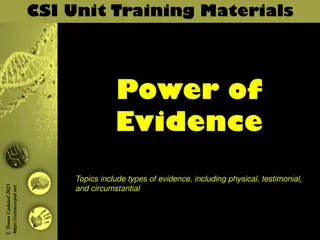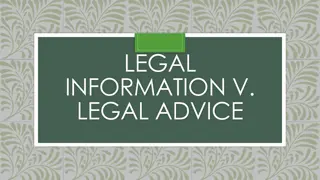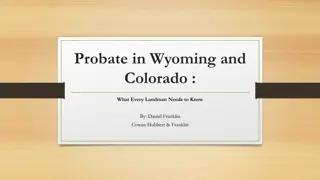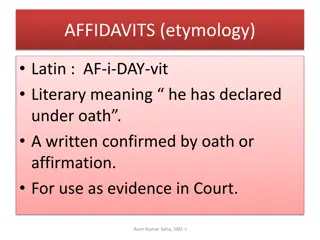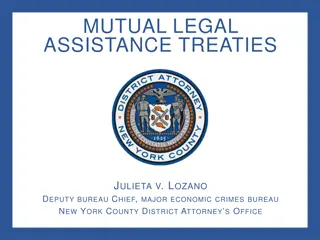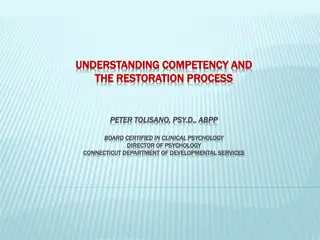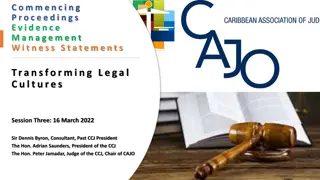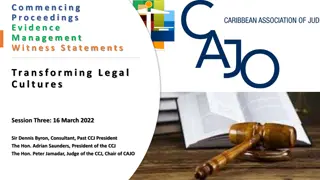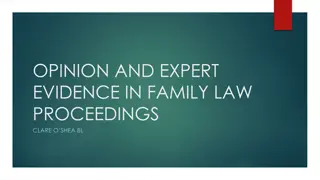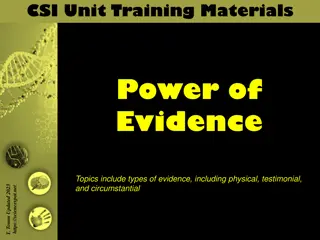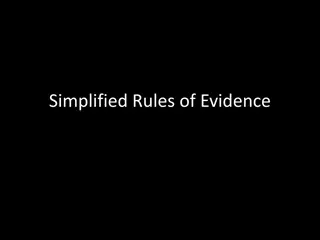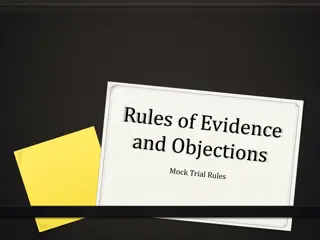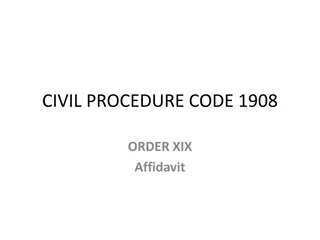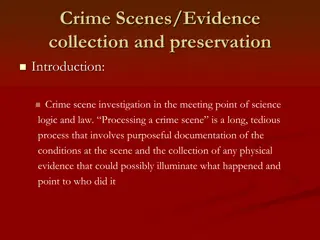Understanding Circumstantial Evidence in Legal Proceedings
Circumstantial evidence plays a crucial role in legal proceedings, allowing one to infer facts based on surrounding circumstances rather than direct proof. This type of evidence can be powerful in establishing the guilt or innocence of a person accused of a crime, complementing direct evidence for a more comprehensive understanding of a case.
Download Presentation

Please find below an Image/Link to download the presentation.
The content on the website is provided AS IS for your information and personal use only. It may not be sold, licensed, or shared on other websites without obtaining consent from the author. Download presentation by click this link. If you encounter any issues during the download, it is possible that the publisher has removed the file from their server.
E N D
Presentation Transcript
MEANING OF EVIDENCE The word Evidence has been derived from the Latin word evidere which implies to show distinctly, to make clear to view or sight, to discover clearly, to make plainly certain, to certain, to ascertain, to prove. According to Sir Blackstone, Evidence signifies that which demonstrates, makes clear or ascertain the truth of the facts or points in issue either on one side or the other. According to Sir Taylor, Law of Evidence means through argument to prove or disprove any matter of fact. The truth of which is submitted to judicial investigation.
EVIDENCE MEANS AND INCLUDES EVIDENCE MEANS AND INCLUDES- - (1) All the statements which the court permits or requires to be made before it by witnesses, in relation to matters of fact under enquiry; such statements are called Oral evidence; (2) All the documents including electronic records produced for the inspection of the court; such documents are called documentary evidence; The definition of Evidence given in this Act is very narrow because in this evidence comes before the court by two means only- (1) The statement of witnesses. (2) Documents including electronic records.
Circumstantial evidence is a very tricky thing, answered Holmes thoughtfully.
EVIDENCE- DIRECT EVIDENCE Direct evidence is evidence of a fact based on a witness's personal knowledge or observation of that fact. A person's guilt of a charged crime may be proven by direct evidence if, standing alone, that evidence satisfies a judge beyond a reasonable doubt of the person's guilt of that crime.
CIRCUMSTANSTIAL EVIDENCE Circumstantial evidence is direct evidence of a fact from which a person may reasonably infer the existence or nonexistence of another fact. A person's guilt of a charged crime may be proven by circumstantial evidence, if that evidence, while not directly establishing guilt, gives rise to an inference of guilt beyond a reasonable doubt. Circumstantial evidence is evidence of circumstances Circumstantial evidence is evidence of circumstances which can be relied upon not as proving a fact directly which can be relied upon not as proving a fact directly but instead as pointing to its existence. but instead as pointing to its existence. Circumstantial evidence is based largely on inference and uses inductive reasoning inductive reasoning.
EXAMPLE OF CIRCUMSTANSTIAL EVIDENCE X is suing his wife, Y, for a divorce, claiming she is having an affair with Z. Z's fingerprints are found on a book in X and Y's bedroom. A judge may infer that Z was in the bedroom. The fingerprints are circumstantial evidence of Z's presence in the bedroom.
CIRCUMSTANTIAL EVIDENCE- COMPLEX Circumstantial evidence is more complex. A witness did not see the stabbing. The witness did see the defendant go into the house carrying a knife. The witness heard a scream inside the house and saw the defendant run out, not carrying the knife. The victim is later found inside with a knife in her back. A reasonable inference is that the defendant stabbed the victim. Whether that fact is true will determine if the defendant is guilty.
CRIMES SCENE INVESTIGATIONS The proper recognition, documentation, reconstruction, submission of relevant evidence, and preservation of evidence is critically important in all crimes scene investigations.
WEIGHT OF CIRCUMSTANSTIAL EVIDENCE It is a popular misconception that circumstantial evidence carries less weight or importance than direct evidence. This is only partly true. While direct evidence is generally seen as more powerful, most successful prosecutions rely greatly on circumstantial evidence. Circumstantial evidence often has an advantage over direct evidence because it is more difficult to suppress or fabricate. The law draws no distinction between circumstantial evidence and direct evidence in terms of weight or importance. Either type of evidence may be enough to establish guilt beyond a reasonable doubt, depending on the facts of the case as the jury finds them to be. Human agency may be faulty in expressing Human agency may be faulty in expressing picturization actual incident but the circumstances cannot fail. Therefore, actual incident but the circumstances cannot fail. Therefore, many a times, it is aptly said that men may tell many a times, it is aptly said that men may tell lies, but circumstances do not . circumstances do not . picturization of of lies, but
FIVE GOLDEN PRINCIPLES OF CIRCUMSTANTIAL EVIDENCE Sharad Sharad v. State of Maharashtra v. State of Maharashtra (AIR 1984 SC 1622) 1) the circumstances from which the conclusion of guilt is to be drawn should be fully established. 2) the facts so established should be consistent only with the hypothesis of the guilt of the accused, that is to say, they should not be explainable on any other hypothesis except that the accused is guilty. 3) the circumstances should be of a conclusive nature and tendency unerringly pointing towards the guilt of the accused. 4) they should exclude every possible hypothesis except the one to be proved, and 5) there must be a chain of evidence so complete chain of evidence so complete as not to leave any reasonable ground for the conclusion consistent with the innocence of the accused and must show that in all human probability the act must have been done by the accused. These five golden principles, constitute the panchsheel of the proof of a case based on circumstantial evidence.
PRINCIPLE OF CIRCUMSTANTIAL EVIDENCE AS LAID DOWN BY SC Shanti Shanti Devi vs. State of Rajasthan Devi vs. State of Rajasthan [CRIMINAL APPEAL NO. 954 OF 2005]. The principles can be set out as under: (i) The circumstances from which an interference of guilt is sought to be proved must be conjointly or firmly established. (ii) The circumstances should be of a definite tendency unerringly pointing towards the guilt of the accused. (iii) The circumstances taken cumulatively must form a chain so complete that there is no escape from the conclusion that with an all human probability, the crime was committed by the accused or none else. (iv) The circumstances should be incapable of explanation on any reasonable hypothesis, same that of the guilt of the accused. [Para 8]
PADALA VEERA REDDY V. STATE OF ANDHRA PRADESH, (1989) SUPP (2) SCC 706 The principles are reiterated as follows; (1) the circumstances from which an inference of guilt is sought to be drawn, must be cogently and firmly established; (2) those circumstances should be of a definite tendency unerringly pointing towards guilt of the accused; (3) the circumstances, taken cumulatively, should form a chain so complete that there is no escape from the conclusion that within all human probability the crime was committed by the accused and none else; and (4) the circumstantial evidence in order to sustain conviction must be complete and incapable of explanation of any other hypothesis than that of the guilt of the accused and such evidence should not only be consistent with the guilt of the accused but should be inconsistent with his innocence.
C. CHENGA REDDY V. STATE OF A.P. (1996) 10 SCC 193 21. In a case based on circumstantial evidence, the settled law is that the circumstances from which the conclusion of guilt is drawn should be fully proved and such circumstances must be conclusive in nature. Moreover, all the circumstances should be complete and there should be no gap left in the chain of evidence. Further, the proved circumstances must be consistent only with the hypothesis of the guilt of the accused and totally inconsistent with his innocence.
TRIMUKH MAROTI KIRKAN VS. STATE OF MAHARASHTRA, (2006) 10 SCC 681 12. In the case in hand there is no eyewitness of the occurrence and the case of the prosecution rests on circumstantial evidence. The normal principle in a case based on circumstantial evidence is that the circumstances from which an inference of guilt is sought to be drawn must be cogently and firmly established; that those circumstances should be of a definite tendency unerringly pointing towards the guilt of the accused; that the circumstances taken cumulatively should form a chain so complete that there is no escape from the conclusion that within all human probability the crime was committed by the accused and they should be incapable of explanation on any hypothesis other than that of the guilt of the accused and inconsistent with their innocence.
NIZAM VS. STATE OF RAJASTHAN DATED SEPTEMBER 4, 2015 In case of circumstantial evidence, court has to examine the entire evidence in its entirety and ensure that the only inference that can be drawn from the evidence is the guilt of the accused. For establishing the guilt circumstantial evidence, the circumstances must be firmly established circumstances must be completed from the facts. The chain of circumstantial evidence cannot be said to be concluded in any manner sought to be urged by the prosecution. on the basis of the and the chain of
THE SAME PRINCIPLES WERE REITERATED IN Bodhraj Bodhraj vs. State of Jammu & Kashmir vs. State of Jammu & Kashmir (2002 (8) SCC 45, Bharat vs. State of Maharashtra Bharat vs. State of Maharashtra (2003 (3) SCC 106), Jaswant Jaswant Gir Gir vs. State of Punjab vs. State of Punjab (2005(12) SCC 438), Reddy Reddy Sampath Sampath Kumar vs. State of Kumar vs. State of Andra (2005 (7) SCC 603), Deepak Deepak Chandrakant Chandrakant Patil Patil vs. State of Maharashtra (2006 (10) SCC 151, State of Goa vs. Sanjay State of Goa vs. Sanjay Takran Takran (2007 (3) SCC 755) and Sattatiyya Sattatiyya alias alias Satish Satish Rajanna Rajanna Kartalla Maharashtra Maharashtra (2008 (3) SCC 210). Andra Pradesh Pradesh vs. State of Maharashtra Kartalla vs. State of vs. State of
ROHTASH ROHTASH KUMAR KUMAR VS [(2013) 14 SCC 434] [(2013) 14 SCC 434] VS STATE OF HARYANA STATE OF HARYANA The evidence regarding the existence of a motive which operates in the mind of the accused is very often very limited, and may not be within the reach of others. The motive driving the accused to commit an offence may be known only to him and to no other. In a case of circumstantial evidence, motive may be a very relevant factor. However, it is the perpetrator of the crime alone who is aware of the circumstances that prompted him to adopt a certain course of action, leading to the commission of the crime. Therefore, if the evidence on record suggests adequately, the existence of the necessary motive required to commit a crime, it may be conceived that the accused has in fact, committed the same.
BURDEN OF PROOF AND CIRCUMSTANTIAL EVIDENCE In Sharad Sharad Birdhichand Maharashtra, Maharashtra, while dealing with circumstantial evidence, it has been held that the onus was on the prosecution to prove that the chain is complete and the infirmity of lacuna in prosecution cannot lacuna in prosecution cannot be cured by false be cured by false defence defence or plea precedent in the words of this Court, before conviction could be based on circumstantial evidence, must be fully established. (SCC p. 185, para 153) Birdhichand Sarda Sarda v. State of v. State of or plea. The conditions
STATE OF RAJASTHAN VS. THAKUR SINGH (2014) 12 SCC 211 Their Lordships of the Hon ble Supreme Court in State of Rajasthan Vs. State of Rajasthan Vs. Thakur 12 12 Scc Scc 211 211 have held that in a case of unnatural death of wife of accused in a room occupied only by both of them, when there was no evidence of anybody else entering the room and the accused has not explained the circumstances about unnatural death of his wife, the principle under Section 106 of the Evidence Act, 1872 was clearly applicable Evidence Act, 1872 was clearly applicable. Thakur Singh (2014) Singh (2014) Section 106 of the
CIRCUMSTANTIAL EVIDENCE & CORROBORATION Circumstantial evidence is a collection of facts that, when considered together, can be used to infer a conclusion about something unknown. Circumstantial evidence is used to support a theory of a Circumstantial evidence is used to support a theory of a sequence of events. sequence of events. The sum total of multiple pieces of corroborating evidence, each piece being circumstantial alone, build an argument to support how a particular event happened. In civil and criminal investigations, corroboration is often supplied by one or more expert witnesses who provide forensic evidence. Circumstantial evidence is usually a theory, supported by a significant quantity of corroborating evidence. The circumstantial evidence being totally based on circumstances is necessarily required to be established by the prosecution only by way of corroborating circumstances surrounding the event or offence and thus viewed, corroboration is an integral part of such type of evidence i.e., circumstantial evidence.
CIRCUMSTANTIAL EVIDENCE & EXTRA JUDICIAL CONFESSION The Supreme Court bench comprising of Justices J M The Supreme Court bench comprising of Justices J M Panchal S S Thakur Thakur . . Commenting on the reliability of extra judicial confession stated that the same was considered to be a weak piece of evidence by the courts. This Court finds that there is neither any rule of law nor of prudence that the evidence furnishing extra judicial confession cannot be relied upon corroborated by some other credible evidence. The evidence relating to extra judicial confession can be acted upon if the evidence about extra judicial confession comes from the mouth of a witness who appears to be unbiased and in respect of whom even remotely nothing is brought out which may tend to indicate that he may have a motive for attributing an untruthful statement to the accused. the bench observed. Panchal and T and T extra judicial confession, the bench unless
CIRCUMSTANTIAL EVIDENCE & SECTION 313 OF CRPC The Supreme Court bench comprising of Justices J M The Supreme Court bench comprising of Justices J M Panchal Thakur Thakur . . Aftab Ahmad Anasari and one Mumtaz were prosecuted for commission of rape and murder of Yasmeen aged five years. daughter of Nayeem Ahmad and for causing disappearance of evidence of those offences. The bench, while explaining the law relating to circumstantial evidence has also ruled that where circumstances proved are put to the accused through his examination under Section 313 of the criminal procedure Code and the accused merely denies the same, then such denial would be an additional link in the chain of circumstances link in the chain of circumstances to bring home the charge against the accused. In this case the appellant merely denied the averments raised and failed to explain the circumstances proved. Therefore such a failure will have to be treated as an additional link in the chain of circumstances to charge the Ansari, the appellant. In consequence of the facts and circumstances of the case, the bench dismissed the appeal filed by Ansari. Panchal and T S and T S denial would be an additional
In Ganeshlal Ganeshlal Vs 106 106 in which case the appellant was prosecuted for the murder of his wife inside his house. Since the death had occurred in his custody, it was held that the appellant was under an obligation obligation to to give cause of death in his statement under Section 313 of the Code of Criminal Procedure. A denial of the prosecution case coupled explanation explanation was was held held to to be innocence innocence of of the the accused, accused, but hypothesis hypothesis that that the the appellant appellant was the the commission commission of of murder murder of of his Vs. . . . State State of of Maharashtra, Maharashtra, 1992 1992 3 3 SCC SCC give an an explanation explanation for the with inconsistent with but consistent consistent with was a a prime prime accused his wife wife absence absence of of with the with the accused in in any any the the be inconsistent
CIRCUMSTANTIAL EVIDENCE: SOUL BASIS OF CONVICTION In Ramawati Ramawati Devi vs. State of Bihar Devi vs. State of Bihar wherein it has been held as follows:- What evidentiary value or weight has to be attached to such statement, must necessarily depend on the facts and circumstances of each particular case. In a proper case, it may be permissible to convict a person only on the basis of a dying declaration dying declaration in the light of the facts and circumstances of the case........
As pointed out by Fazal Ali, J, in V.C. State State" in most cases it will be difficult to get direct evidence of the agreement, but a conspiracy can be inferred conspiracy can be inferred even from circumstances giving rise to a conclusive or irresistible inference of an agreement between two or more persons to commit an offence. V.C. Shukla Shukla vs. vs.
As per Wadhwa, J. in Nalini's Nalini's case. case. The well known rule governing circumstantial evidence is that each and every incriminating circumstance must be clearly established by reliable evidence and "the circumstances proved the circumstances proved must form a chain of events must form a chain of events from which the only irresistible conclusion about the guilt of the accused can be safely drawn and no other hypothesis against the guilt is possible.
Similarly in the famous case of Bodh & Kashmir, & Kashmir, Court held that circumstantial evidence can be a sole basis for conviction provided the conditions as stated below is fully staisfied. Condition are: 1) The circumstances from which guilt is established must be fully proved; 2) That all the facts must be consistent with the hypothesis of the guilt of the accussed; 3) That the circumstances must be of a conclusive nature and tendency ; a. That the circumstances should, to a moral certanity , actually exclude every hypotheis expectthe one proposed to be proved. Bodh Raj V. State of Jammu Raj V. State of Jammu
PRIYADHARSHANI MATTO CASE 'That I know the defendant is guilty, my hands are tied. As a judge, I 'That I know the defendant is guilty, my hands are tied. As a judge, I can only go by the evidence provided by the investigative agencies.' can only go by the evidence provided by the investigative agencies.' These were the words of Additional Sessions Judge G P Thareja, who acquitted Santosh Kumar Singh, Delhi University law student who committed rape and murder of Priyadharshani Matto. But However the Delhi High court said that the overall analysis of the circumstances proved beyond doubt and the evidence is unimpeachable that Singh has committed rape and murder. "We are of the view to convict him (Singh) under section 302 (murder) and 376 (rape) of the Indian Penal Code," the Bench said. The Court observed that the trial court verdict was "perverse" and shocked the observed that the trial court verdict was "perverse" and shocked the judicial conscience. The court said the evidence was incompatible judicial conscience. The court said the evidence was incompatible with Singh's plea of innocence and "we held him guilty of the offence with Singh's plea of innocence and "we held him guilty of the offence he committed". he committed". The Court
LAST SEEN THEORY In State of Rajasthan State of Rajasthan vs. 23. 23. It is not necessary to multiply with authorities. The principle is well settled. The provisions of Section 106 of the Evidence Act itself are unambiguous and Section 106 of the Evidence Act itself are unambiguous and categoric in laying down that when any fact is especially within the knowledge of a person, the in laying down that when any fact is especially within the knowledge of a person, the burden of proving that fact is upon him. burden of proving that fact is upon him. Thus, if a person is last seen with the deceased, he must offer an explanation as to how and when he parted company. He must furnish an explanation which appears to the court to be probable and satisfactory. If he does so he must be held to have discharged his burden. If he fails to offer an explanation on the basis of facts within his special knowledge, he fails to discharge the burden cast upon him by Section 106 of the Evidence Act. In a case resting on circumstantial evidence if the accused fails to offer a reasonable explanation in discharge of the burden placed on him, that itself provides an explanation in discharge of the burden placed on him, that itself provides an additional link in the chain of circumstances proved against him additional link in the chain of circumstances proved against him. Section 106 does not shift the burden of proof in a criminal trial, which is always upon the prosecution. It lays down the rule that when the accused does not throw any light upon facts which are specially within his knowledge and which could not support any theory or hypothesis compatible with his innocence, the court can consider his failure to adduce any explanation, as an additional link which completes the chain. vs. Kashi Kashi Ram, (2006) 12 SCC 254, Ram, (2006) 12 SCC 254, this Court held as under:- categoric accused fails to offer a reasonable
FACT OTHERWISE DOUBTFUL MAY BE INFERRED FROM CERTAIN OTHER PROVED FACTS Their Lordships of the Hon ble Supreme Court in Tulshiram Tulshiram Sahadu Sahadu Suryawanshi Suryawanshi and another Vs. State of Maharashtra(2012) 10 SCC 373 State of Maharashtra(2012) 10 SCC 373 have held held that a fact otherwise doubtful may be inferred from certain other proved facts. When inferring the existence of a fact from other set of proved facts, the Court exercises a process of reasoning and reaches a logical conclusion as to the most probable position. The principles embodied in Section 106 of the Evidence Act can also be utilized. and another Vs.
INSPECTOR OF POLICE, TAMIL NADU V. JOHN DAVID Every incriminating circumstance must be clearly established by reliable and clinching evidence and the circumstances so proved must form a chain of events from which the only irresistible conclusion that could be drawn is the guilt of the accused and that no other hypothesis against the guilt is possible. This Court has clearly sounded a note of caution that in a case depending This Court has clearly sounded a note of caution that in a case depending largely upon circumstantial evidence, there is always a danger that conjecture largely upon circumstantial evidence, there is always a danger that conjecture or suspicion may take the place of legal proof. or suspicion may take the place of legal proof. The Court must satisfy itself that various circumstances in the chain of events have been established clearly and such completed chain of events must be such as to rule out a reasonable likelihood of the innocence of the accused. It has also been indicated that when the important link goes, the chain of circumstances gets snapped and the other circumstances cannot in any manner, establish the guilt of the accused beyond all reasonable doubts. It has been held that the Court has to be watchful and avoid the danger of allowing the suspicion to take the place of legal proof. It has been indicated by this Court that there is a long mental distance between 'may be true' and 'must be true' and the same divides conjectures from sure conclusions.
K.RAMARAJ K.RAMARAJ VS BY ON 12 DECEMBER, 2013 BY ON 12 DECEMBER, 2013 VS STATE STATE Lt.Col.Ramaraj retired from service and was living in the army quarters, D.No.11/4 in the first floor, Officers Enclave, Old Fort, Chennai. The deceased boy Dilshan is the son of Kalaivani and they lived on the opposite side of the Army Quarters in the hutments called Indira Nagar Colony. There are no eye witnesses in this case and the entire case hinges on circumstantial evidence. The Conduct Of The Appellant In Throwing The M.O. Into Coovum River Established through circumstantial evidence . The prosecution has satisfactorily established that the appellant was the owner of the weapon. The prosecution has also established that the weapon was retrieved from the Coovum river based on the disclosure statement of the appellant. The concept of 'proof beyond reasonable doubt' is relatable to the quality of evidence which prosecution should adduce in a criminal case.
STATE BY THE INSPECTOR OF POLICE STATE BY THE INSPECTOR OF POLICE VS MANOHARAN MANOHARAN ON 24 MARCH, 2014 ON 24 MARCH, 2014 VS Satiating his lust and sniffing out the life of two children. (i) The offence is one of rape of a minor and murder of two children; (ii) The hands of 'X' were tied behind and one after the other they have raped her; (iii) After committing rape, cow dung powder which contains auramine and which is normally used for committing suicide was purchased from a shop and milk was purchased from another shop. (iv) Thereafter, they mixed the cow dung powder and milk and filled it in a water bottle and gave it to the children. Both the children drank a little bit of it and spit the balance in the car. Then the accused realised that since the children had spit the milk mixed with poison, they may not die. They wanted to make sure that the children die and so they took the children to Deepalapatti, a secluded place in the outskirts of Coimbatore District, where the P.A.P. canal flows with gusto. (v) They pushed one child after the other and the body of the children were recovered several kilometres away in the canal. Manoharan pushed 'Y' and the body was recovered 12 km away from Deepalapatti two days later. Here both the victims were innocent, helpless and defenceless children.
UJJAGAR UJJAGAR SINGH VS. STATE OF PUNJAB(2007) 13 SINGH VS. STATE OF PUNJAB(2007) 13 SCC SCC Held Held that while evaluating circumstantial evidence, whether a chain of evidence is complete or not would depend on the facts of each case emanating from the evidence and no universal yardstick should ever be attempted.
GAGAN GAGAN KANOJIA KANOJIA AND ANOTHER VS. STATE OF AND ANOTHER VS. STATE OF PUNJAB (2006) 13 SCC 516 PUNJAB (2006) 13 SCC 516 The prosecution case is based on circumstantial evidence. Indisputably, charges can be proved on the basis of the circumstantial evidence, when direct evidence is not available. It is well-settled that in a case based on a circumstantial evidence, the prosecution must prove that within all human probabilities, the act must have been done by the accused. It is, however, necessary for the courts to remember that there is a long gap between may be true and must be true. Prosecution case is required to be covered by leading cogent, believable and credible evidence. Whereas the court must raise a presumption that the accused is innocent and in the event two views are possible, one indicating to his guilt of the accused and the other to his innocence, the defence available to the accused should be accepted, but at the same time, the court must not reject the evidence of the prosecution, proceeding on the basis that they are false, not trustworthy, unreliable and made on flimsy grounds or only on the basis of surmises and conjectures. The prosecution case, thus, must be judged in its entirety having regard to the totality of the circumstances. The approach of the court should be an The approach of the court should be an integrated one and not truncated or isolated. The court should use the integrated one and not truncated or isolated. The court should use the yardstick of probability and appreciate the intrinsic value of the evidence yardstick of probability and appreciate the intrinsic value of the evidence brought on records and analyze and assess the same objectively. brought on records and analyze and assess the same objectively.


